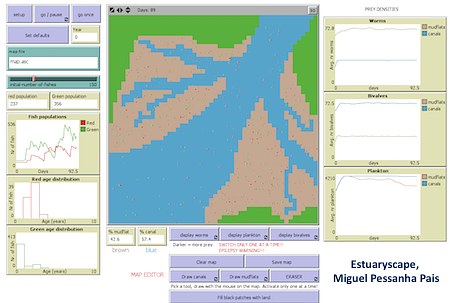
- 20 Dec 2016
What do climate change, human demographics, consumer choices, invasive species, entropy, voter dynamics, and social inequality have in common? They are all subjects of projects created by students for the Introduction to Agent-based Modeling course, which launched for the first time on Complexity Explorer in June 2016. Now that the first session of the course has wrapped up, we’d like to share a few insights and stories from some of Bill Rand’s students.
The students we spoke with were a diverse, international set coming from the USA, Europe, South America and India, representing four of the seventy countries enrolled students belonged to. Some of them have been long time Complexity Explorer students, having first taken a course in 2013 with Melanie Mitchell’s very first Introduction to Complexity session. For others, this was their first introduction to Complexity Explorer. Their level of experience with programming and agent-based models also ranged widely, as well as their career progressions. Some of the students we spoke to were just finished with their undergraduate degree, while others were past the PhD stage.
This is quite representative of the students who choose to enroll in Complexity Explorer courses in general. 59% of enrolled students were aged 25-44, though there were students ranging in age from 12 to 75 or older. Women made up 16% of the enrolled students. When asked at the beginning of the course what their intentions were regarding tuition, 23% of enrolled students said they intended to pay, while 27% said they would decide after the first unit, and 16% were going to wait to access the course materials once the course had closed.

Students overwhelmingly loved the course
The course has been rated highly by students on Class Central, and in our post-course evaluations.
For Miguel Pessanha Pais, the way Bill Rand used examples to explain everything was key. He and many of the students we spoke to all agreed that they felt well supported by the course team and fellow students through the live streaming office hours and the forum. “Being a lonely modeler for some time it felt really good to have a group of people with a common interest willing to help each other solve NetLogo problems or discuss ideas” (Miguel).


Other aspects of the course that proved valuable for students who had not spent much time programming beforehand included the course structure, with gradual introductions to various modeling concepts. For Kalai Ramea, this was key in her discovery of the potential of ABMs to address quite complex concepts. John Thomas particularly loved the demystification of the thinking process involved in creating and validating the ABM models alongside the practical demonstration of how exactly to go about doing it.


The interdisciplinary nature of agent-based modeling was what stood out most for Georgios Papadopoulos, as well as the possibility to create a project on whatever topic might be of interest to the student.
We spoke with a mixture of students who had either chosen to pay the minimum tuition fee for the course or had received a scholarship to cover the course costs. They all considered the fee to be fair, and the scholarship process key to ensure that students with genuine interest but without the means to pay could still participate. For some of the students, like Miguel Vazquez Carrero and Diego Diaz, receiving a scholarship or paying for the course helped give them a little motivational push to work hard and complete the course.
Highlighted Models
One of the more exciting aspects of this course, as Georgios mentioned above, was the opportunity for every student to create their own agent-based model on any subject they were interested in. All of the students we spoke to shared their models with us, and the subjects they chose to model were incredibly varied and creative. We invite you to follow the links provided to see the detailed descriptions of all of the models, and perhaps to download NetLogo and the models and take some time to play with the models. You’ll be impressed at what the students managed to achieve in a very short time.
Paula Palacios, a student in Colombia, took her time trying to decide what to model, and finally decided on entropy as a subject. She created a version of the Maxwell’s demon thought experiment, in which a creature, called the demon, opens and closes a membrane separating two rooms filled with gas particles to separate particles according to their velocities, contradicting the second law of thermodynamics by reverting entropy. In Paula’s model the particles, instead of a demon, decide whether to cross the membrane based on local information. Paula’s model benefited greatly from Bill Rand’s office hours, and also feedback from another student on the course, Sebastian Narvaez. With what she has learned creating this model and by taking the course, she hopes to start modeling animal behavior based on swarm intelligence and using machine learning. See Paula's model here.
Shipra Ghosh, based in India, created a model addressing voter dynamics of a population within a neighborhood. It examines the case in which two persons are running in a neighborhood election with opposing views, and asks how neighbors align themselves as a function of proximity to the candidates. The model was inspired in part by Uri Wilensky’s NetLogo Segregation model. See Shipra's model here.
Kalai Ramea, located in the USA, investigated how consumers choose different vehicle technologies (gasoline, electric and fuel cell vehicles), based on the vehicles’ attributes, driving behavior and infrastructure availability. She is an early career researcher who just finished her PhD in mathematical modeling of energy and transportation systems. With this course under her belt, she hopes to identify how infrastructure and vehicle purchase behavior interact in a GIS framework in an ABM for different neighborhoods around the world. See Kalai's model here.
Miguel Pessanha Pais of Portugal was interested in modeling the effect climate change could have on the distribution of fish species. In his model, he simulated the spatial interaction of two flatfish and three prey types in an estuary. Miguel has a PhD in Marine Biology and one striking conclusion of his research was the difficulty of predicting which fish should be at a particular site given the state of the system. He hopes agent-based models can help him seek answers for some of the issues he encountered in his PhD research. While Miguel says he felt like he was in Agent-based Modeling kindergarten, his peers would likely disagree – he has been teaching himself NetLogo for the past two years and was very active in the course forums, helping other students when he could. He refers to his model as a work in progress but it, like the other models we have featured here, is very much worth checking out. See Miguel's model here.

All in all the models were of high quality and we wish we could feature them all. Explore some other models here:
See John Thomas' model on invasive ants here: http://modelingcommons.org/browse/one_model/4828#model_tabs_browse_info
See Georgios Papadopoulos' model on income distribution here: http://modelingcommons.org/browse/one_model/4826
See Alberto Cottica's model on online communities here: http://modelingcommons.org/browse/one_model/4947
Improvements in the future
Of course, no course is perfect and things can always be tweaked. There were hiccups in the course related to the new peer review assignment system that were almost completely solved by the end of the course, but we will be working to improve it before it is used again. Based on feedback and his own experience creating the course, Bill Rand is going to be updating parts of units 6 through 9, and extending the course a little to allow more time to develop final projects.


One major addition we plan to work on before the next session is adding captions and subtitles to the videos. We rely on volunteers to make this happen, so join our subtitle team if you haven’t already and start captioning!
Did you take part in the course? Did you add your final project to the Modeling Commons? Comment with a link to your project!
